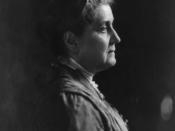The settlement movement began with the founding of Toynbee Hall, in East London in 1884. The Anglican clergyman Samuel Augustus Barnett and a group of Oxford men joined him and his wife in "settling" in a deprived area of the city. "In residing among the poor, they would become neighbors and friends, sharing the concerns of the district and the cultural advantages of their fortunate birth and education" (Carson, 1). The movement spread to the United States in 1886 when Charles B. Stover and Stanton Coit, "an American lecturer at the West London Ethical Society and early visitor to Toynbee Hall," established Neighborhood Guild, now the University Settlement, on the Lower East Side of New York City.
By 1890 settlement houses had been established in Boston, New York, and Chicago, by people working independently believing the same idea. Though these people had differences in their religious, geographic, and social backgrounds, the American founders shared the same ideas and values that started the settlement idea.
One of the first settlement houses that had been established was in Chicago of 1889, by Jane Addams. Jane Addams bought a house in a poor immigrant neighborhood on the West Side that came to be known as the Hull House. In the same year the educator Jane E. Robbins and Jean Fine opened the College Settlement in New York City. Two years later Robert A. Woods, another resident of Toynbee Hall, and William J. Tucker established Andover House, later called South End House in Boston.
Most of the settlements began as cooperative living arrangements. Often the association or individuals paid the rent while the residents paid board, took at least the evening meal and kept their rooms neat; though the house usually hired servants to do the cooking and cleaning. They all...
![[Portrait of Eddie Davis and Sherry Britton, Leon and Eddie's, New York, N.Y., ca. July 1948] (LOC)](https://s.writework.com/uploads/3/36886/portrait-eddie-davis-and-sherry-britton-leon-and-eddie-s-ne-thumb.jpg)

